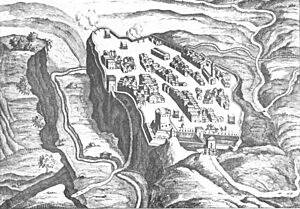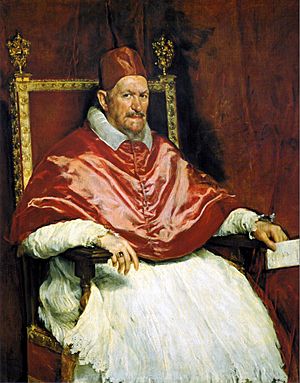Wars of Castro facts for kids
Quick facts for kids The Wars of Castro |
|||||||
|---|---|---|---|---|---|---|---|
 The city of Castro, on which the Wars of Castro centered. |
|||||||
|
|||||||
| Belligerents | |||||||
| Papal armies of Pope Urban VIII and later of Pope Innocent X | Farnese Dukes of Parma and of Castro – Odoardo Farnese and later Ranuccio II Farnese | ||||||
| Commanders and leaders | |||||||
| Antonio Barberini Fabrizio Savelli, later replaced by Taddeo Barberini Luigi Mattei as commander of papal loyalists and hired mercenaries Achille d'Étampes de Valençay and Cornelio Malvasia as commanders of cavalry |
Mattias de' Medici as commander of the forces of the Republic of Venice, the Grand Duchy of Tuscany and the Duchy of Modena and Reggio Raimondo Montecuccoli as commander of mercenary Modenese forces loyal to Francesco I d'Este |
||||||
The Wars of Castro were a series of fights in the mid-1600s. These conflicts were all about the old city of Castro in Italy. The wars ended with Castro being completely destroyed on September 2, 1649.
The main reason for these wars was a power struggle. On one side was the Pope and his family, the Barberini and Pamphili. On the other side were the Farnese dukes of Parma. The Farnese family controlled Castro and the land around it, known as the Duchy of Castro.
Contents
Why the Wars Started
The politics of the 1600s were quite complex. Different groups and families often changed who they supported. It's hard to say exactly when the problems between the Farnese family and the Pope began. But we can look at events that happened years before the fighting started.
Early Problems and Disputes
In 1611, some nobles were accused of planning to harm Ranuccio I Farnese, Duke of Parma. It turned out these accusations were likely false. Still, many people were punished, and their lands were taken. This made many nobles very unhappy. Ranuccio remained worried about plots against him until he died in 1622.
Tensions grew between the Farnese family and other powerful Italian families. In 1639, Odoardo Farnese, Duke of Parma visited Rome. He was welcomed by the Pope's nephews, Antonio and Francesco Barberini. But Duke Odoardo refused to show proper respect to another of the Pope's nephews, Taddeo Barberini.
When the Duke left, he asked the Pope to scold his nephews. The nephews were very angry. They convinced the Pope to punish the Duke. The Pope stopped grain shipments from Castro from being sold in Rome. This took away a lot of the Duke's money.
Duke Odoardo owed money to many people in Rome. Because he lost income, he could not pay his debts. His creditors asked the Pope for help. The Pope then decided to use his army to make the Duke pay.
Getting Ready for War
Pope Urban VIII decided to help Duke Odoardo's creditors. He sent his nephew Antonio, along with Fabrizio Savelli and Luigi Mattei, to take over Castro. Other commanders like Achille d'Étampes de Valençay and Cornelio Malvasia also joined the papal forces.
At the same time, the Pope sent Cardinal Bernardino Spada to try and solve the problem peacefully. Spada successfully arranged a truce. However, the Pope's military leaders learned that the Duke was gathering his own troops. So, Pope Urban VIII canceled the peace agreement. He said Spada had made the deal without his permission.
Pope Urban VIII had been gathering troops in Rome throughout 1641. Many soldiers and hired fighters filled the city streets. The Pope even pardoned some people who were in prison. He gave them command of his troops because he needed more fighters.
The First War of Castro
On October 12, 1641, Luigi Mattei led a large army of about 12,000 foot soldiers and 4,000 horsemen. They marched towards Castro. The Pope's army met only 40 soldiers guarding a bridge. After a short fight, Castro and other nearby towns quickly gave up.
Fabrizio Savelli, one of the Pope's commanders, was not very eager to fight. So, the Pope's nephew, Taddeo Barberini, took his place as the main general. Taddeo arrived with more troops in Ferrara on January 5, 1642.
On January 13, Pope Urban VIII took away Duke Odoardo's lands and removed him from the Catholic Church. This is called excommunication. Duke Odoardo fought back. He marched his own army towards the Papal States, getting close to Rome. But Odoardo hesitated. The Pope used this time to make Rome stronger and gather a new army of 30,000 soldiers. This new army pushed the Duke back to his own land.
Duke Odoardo then made alliances with other powerful states. He joined forces with Venice, Modena, and Tuscany. Tuscany was led by his brother-in-law, Ferdinando II de' Medici, Grand Duke of Tuscany.
Fighting Continues
At first, Pope Urban threatened to excommunicate anyone who helped Odoardo. But Odoardo's allies said they were fighting the Barberini family, not the Pope himself. The Pope tried to get help from Spain, but Spain was busy with the Thirty Years' War. Most of the Pope's soldiers were French, while most of the Duke's soldiers were German.
The Pope raised taxes and gathered even more soldiers. The war continued. Cardinal Antonio Barberini, Taddeo's brother, had some success against the Venetians and Modenese. However, the Pope's forces lost a big battle near Lake Trasimeno to the Tuscans.
By late 1643, neither side had gained much ground. Both sides had spent huge amounts of money. It is believed that Pope Urban and his allies spent about 6 million thalers during the four years of fighting.
The Pope's forces suffered a major defeat at the Battle of Lagoscuro on March 17, 1644. They were forced to surrender. Antonio Barberini barely escaped capture. Peace was finally agreed upon in Ferrara on March 31.
Peace and Aftermath
Under the peace agreement, Duke Odoardo was allowed back into the Catholic Church. His lands were given back to him. Grain shipments from Castro to Rome were allowed again. Odoardo also agreed to start paying his Roman creditors.
This peace deal ended the First War of Castro. Many people saw it as a failure for the Pope. He had not been able to get his way by force. It is said that Pope Urban was so upset after signing the agreement that he became very ill. He remained sick until he died.
Pope Urban's Death and Barberini Exile
Pope Urban VIII died just a few months after the peace deal, on July 29, 1644. On September 15, Pope Innocent X was chosen to replace him. Pope Innocent X immediately started looking into how the war was paid for. The first war cost the Pope about 12 million scudi. Special taxes were put on the people of Rome to refill the church's money.
The nephews of Pope Urban VIII, Antonio, Taddeo, and Francesco Barberini, had led the Pope's armies. They were forced to leave Rome and go to France. They were helped by Cardinal Mazarin and lived under the protection of King Louis XIV.
Taddeo Barberini died in Paris in 1647. But in 1653, Antonio and Francesco Barberini were allowed to return to Rome. This happened after Taddeo's son, Maffeo Barberini, married Olimpia Giustiniani, a niece of Pope Innocent X. This marriage helped to mend relations between the families.
The Second War of Castro

After the peace agreement, the people of Castro were left alone for a while. But Duke Odoardo Farnese, who signed the peace deal, died in 1646. His son, Ranuccio II Farnese, Duke of Parma, took his place.
In 1649, Duke Ranuccio refused to pay the Roman creditors. This was something his father had agreed to five years earlier. He also refused to accept the new bishop of Castro, Monsignor Cristoforo Giarda, who was chosen by Pope Innocent X. When the bishop was killed on his way to Castro, Pope Innocent X accused Duke Ranuccio and his supporters of the crime.
To get revenge for this alleged crime, the Pope's forces marched on Castro. Duke Ranuccio tried to fight them but was defeated by Luigi Mattei. On September 2, 1649, the city of Castro was completely destroyed by the Pope's orders.
The Pope's troops destroyed not only the city's defenses and buildings but also its churches. This was done to cut all ties between Castro and the Pope. As a final insult, the troops destroyed Duke Ranuccio's family palace, the Palazzo Farnese. They put up a column that read Qui fu Castro, which means "Here stood Castro."
Duke Ranuccio II had to give control of the lands around Castro to the Pope. The Pope then tried to use this land to pay off Ranuccio's debts. This marked the end of the Second War of Castro. The city of Castro was never rebuilt.

